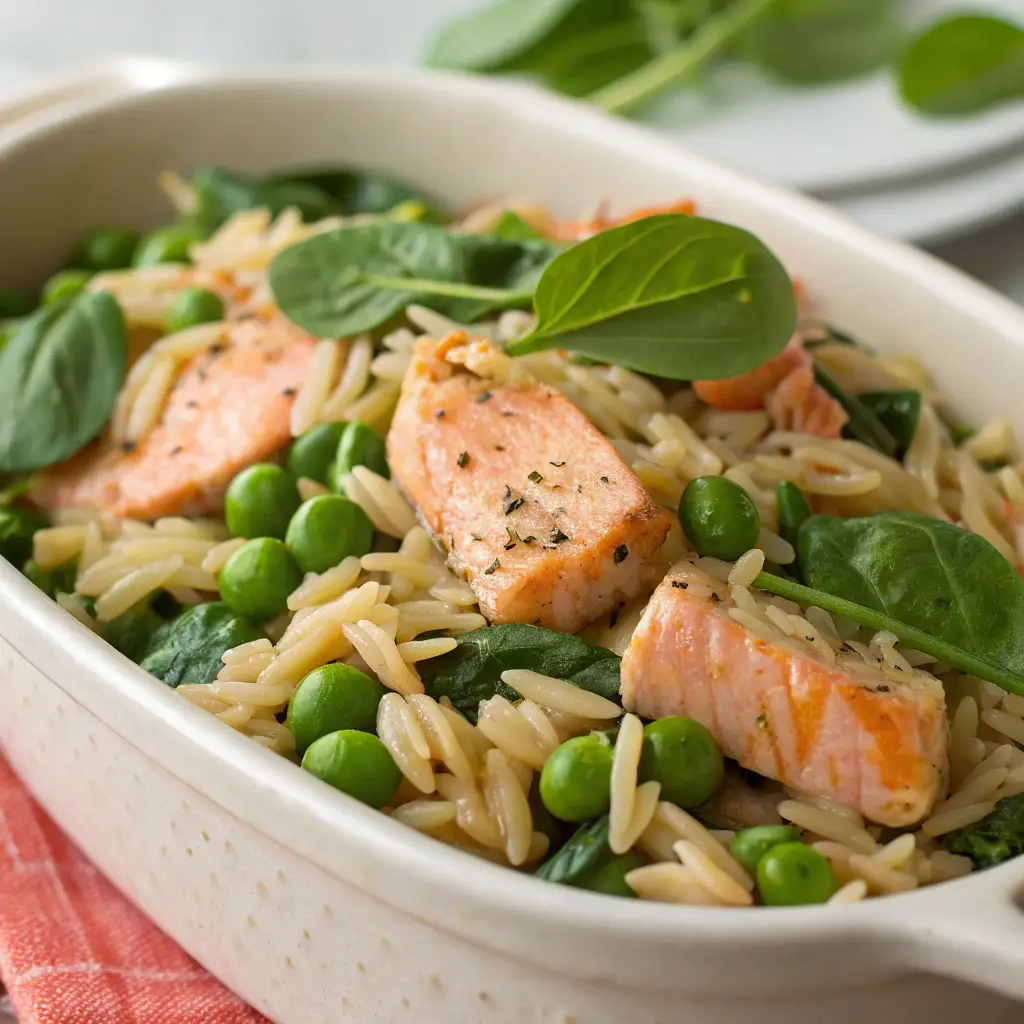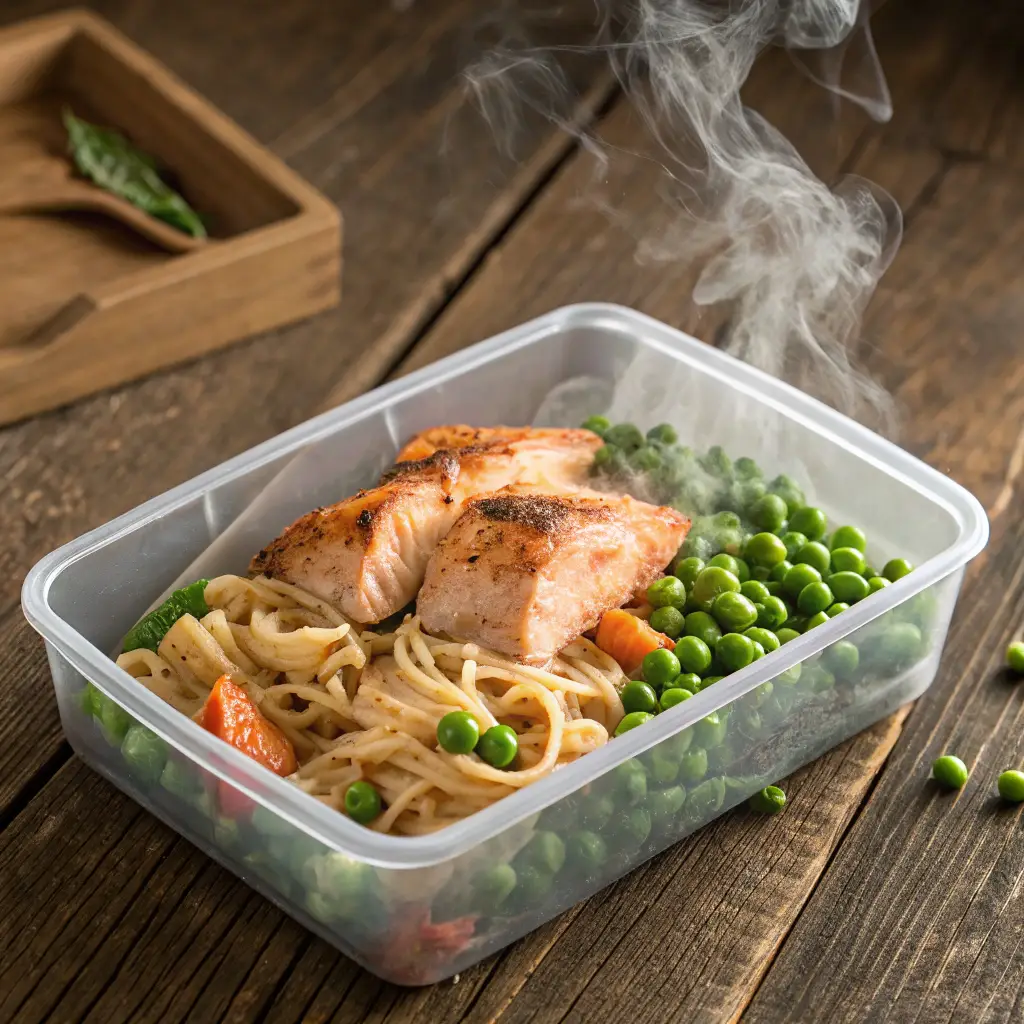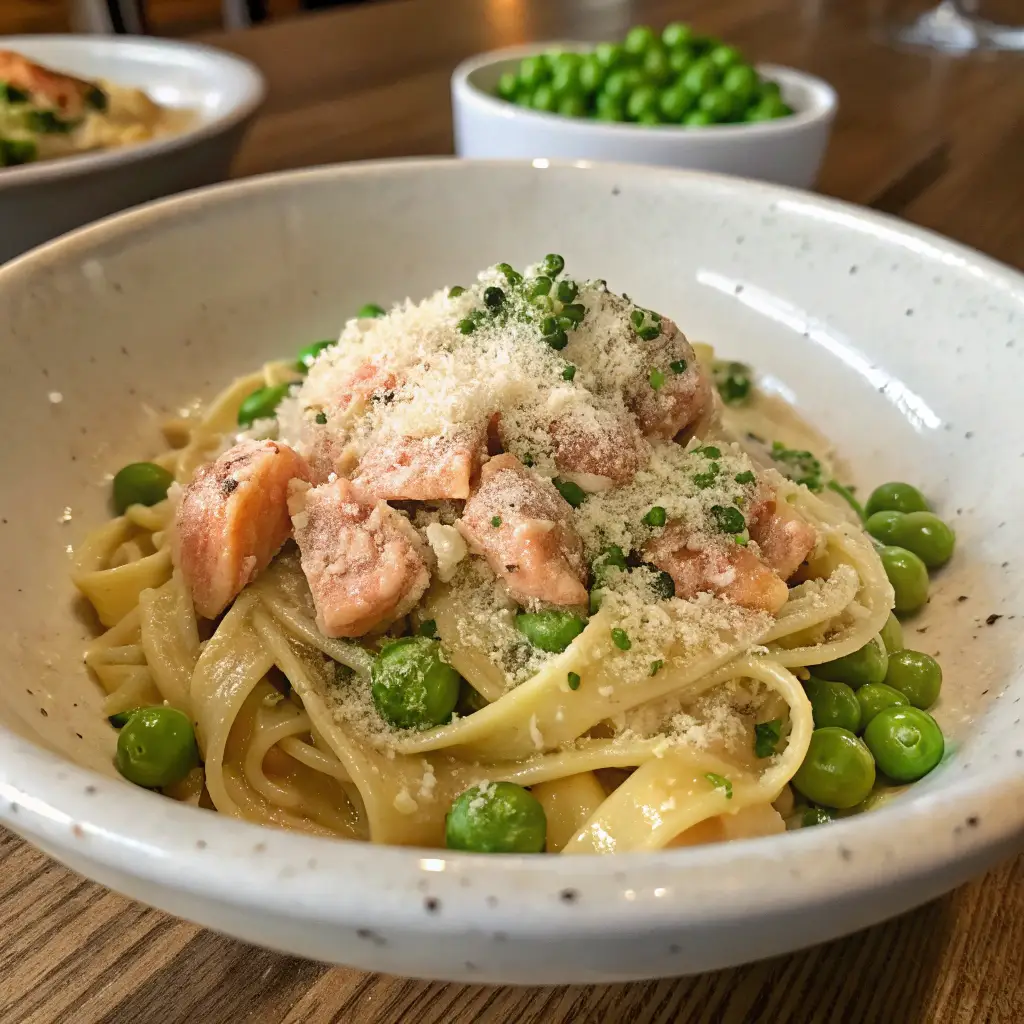Craving a cozy pasta dish that’s fast, flavorful, and packed with nutrients? Look no further than pasta with salmon peas. This one-bowl wonder brings together the rich, buttery texture of salmon with the sweet pop of green peas in a light, creamy sauce. Whether you’re cooking for a weeknight dinner or meal prepping for the week ahead, this pasta is a total win.
You don’t need fancy ingredients or hours in the kitchen—just a handful of pantry staples, fresh or frozen fish, and a pasta shape of your choice. From penne to orzo, this flexible dish can be tailored to your taste. It’s also a great way to get more omega-3s and veggies in your diet without a second thought.
Check out this shrimp-based pasta twist: Shrimp Spaghetti Recipe
Table of Contents
PART 1: Why Pasta with Salmon and Peas Is the Perfect Weeknight Meal
Quick, Easy, and Nutritious: Why It’s a Weeknight Favorite

When you’re short on time but still want a satisfying meal, salmon and pea pasta is the answer. It’s ready in 30 minutes or less and only needs a single pan for cleanup. Plus, it’s a crowd-pleaser, even for picky eaters.
Health Benefits of Salmon and Green Peas in Pasta Recipes
Salmon is loaded with lean protein, brain-boosting omega-3 fatty acids, and B vitamins. Peas add fiber, vitamin C, and antioxidants. This combo doesn’t just taste great—it supports immune health, heart function, and energy levels.
Want something with creamy garlic flavor?
Don’t miss our creamy pasta dish with a garlic punch: Garlic Parmesan Chicken Pasta
PART 2: Ingredients You’ll Need for Salmon and Pea Pasta
Choosing the Right Type of Pasta (Orzo, Penne, Tagliatelle)
The great thing about pasta with salmon peas is its flexibility. You can use almost any pasta you have on hand. Short pasta like penne or fusilli catches the sauce beautifully, while long noodles like tagliatelle offer an elegant texture. If you’re looking for something with a little more bite, try orzo—it’s perfect for absorbing creamy sauces and works well in both hot and cold salmon pasta dishes. For a healthier twist, whole wheat or protein-enriched pasta also does the trick.
Fresh, Frozen, or Canned: What Kind of Salmon Works Best?
When it comes to the salmon, you’ve got options. Fresh salmon gives the dish a premium flavor, especially if it’s pan-seared before being added to the pasta. Frozen salmon fillets are a convenient alternative—just thaw and season.
If you’re in a pinch, canned salmon is totally acceptable. It’s budget-friendly and breaks apart nicely into the sauce, delivering that rich, savory taste in every bite. Just be sure to drain it well and remove any bones or skin if needed.
Why Peas Add More Than Color: Sweetness and Texture Explained
Peas don’t just bring a bright green pop—they balance the richness of the salmon and sauce. Use frozen peas for convenience—they cook quickly and retain their sweetness and snap. If you’re using fresh peas, blanch them first to preserve their color and flavor. Canned peas work in a pinch, though they’re softer and slightly less vibrant.
Together, these simple ingredients transform into a creamy, comforting bowl of goodness that’s easy to customize and hard not to love.
PART 3: Step-by-Step Guide – How to Make Salmon and Pea Pasta
Pan-Seared or Baked: Cooking Salmon the Right Way
Getting the salmon just right is key to the perfect pasta with salmon peas. If you’re using fresh or thawed fillets, pan-searing is a quick and flavorful method. Simply season with salt, pepper, garlic powder, and a touch of lemon juice, then sear in a hot skillet with olive oil for 3–4 minutes per side. You’ll get a golden crust and tender inside.
Prefer to bake it? Wrap salmon in foil with olive oil and lemon slices and bake at 400°F for 12–15 minutes. This method locks in moisture and keeps the fish tender, which is ideal for mixing into creamy sauces.
One-Pot or Separate Prep: Combining Ingredients for the Creamiest Finish
For a fuss-free dinner, try the one-pot method. Cook pasta in a large pot of salted boiling water. About two minutes before it’s done, toss in frozen peas. Drain and reserve a bit of pasta water.
In the same pot, add a splash of olive oil or butter, minced garlic, and a bit of lemon zest. Stir in cooked salmon (flaked into chunks), peas, and pasta. Add a splash of cream or cream cheese for that rich, velvety finish. Loosen with reserved pasta water if needed.
Prefer separate prep? Cook each element on its own, then toss everything together gently just before serving to keep the salmon’s texture intact.
This dish is all about layering flavors and textures. The sweetness of peas, the richness of salmon, and the creaminess of the sauce come together to make a hearty yet balanced pasta dish that’s as good on a weeknight as it is for guests.
PART 4: Sauce for Salmon Pasta – What Works Best
Best Cream-Based Sauces for Pasta with Salmon and Peas

When you think of pasta with salmon peas, a creamy sauce often comes to mind—and for good reason. A smooth, rich sauce brings all the flavors together without overpowering the delicate salmon or sweet peas. Heavy cream or half-and-half serves as a base, enriched with a bit of butter, garlic, and grated Parmesan for depth. Add a splash of pasta water to help the sauce cling to the noodles without getting too thick.
Looking for something a bit lighter? Cream cheese is a fantastic option that adds tanginess and silkiness without feeling too heavy. Stir it in just after the pasta has been drained, letting the residual heat melt it into the ingredients.
Olive Oil and Lemon vs. White Wine Cream Sauce: Flavor Showdown
If creamy isn’t your thing, a lemon olive oil sauce is fresh, vibrant, and perfect for spring and summer. Simply sauté garlic in olive oil, add a squeeze of fresh lemon juice, and finish with parsley and cracked pepper. It’s light, citrusy, and lets the salmon shine.
For more complex flavor, a white wine cream sauce adds elegance to your salmon and pea pasta. Deglaze your pan with dry white wine after cooking garlic and onions, then reduce it before stirring in cream. The acidity from the wine balances the richness and elevates the overall taste.
Each of these sauces works beautifully with the saltiness of salmon and the pop of peas. Whether you go classic creamy, lemony light, or restaurant-style with wine, there’s a sauce here that fits your flavor mood perfectly.
Want to master the perfect white wine sauce? This guide from Serious Eats breaks it down beautifully with pro techniques.
PART 5: Variations You’ll Love – From Salmon Orzo to Pasta e Piselli
How to Make Salmon Orzo with Peas and Spinach
If you’re in the mood for something a little different, try salmon orzo—a variation that’s lighter yet still incredibly satisfying. Orzo is a rice-shaped pasta that cooks quickly and soaks up flavor like a sponge. In this version, cook the orzo in chicken or vegetable broth instead of water for a flavor boost.
Once it’s al dente, stir in cooked, flaked salmon, peas, and a handful of baby spinach. Add a touch of lemon zest, a splash of cream, or even a spoonful of Greek yogurt for a tangy finish. This variation is ideal for lunch or meal prep and tastes great warm or cold.
It’s one of those pasta with salmon peas recipes that feel gourmet but come together in under 30 minutes.
Pasta e Piselli (Pasta and Peas): Classic Italian Comfort Food
Want to keep things traditional? Then meet Pasta e Piselli, the Italian classic that inspired many modern variations. This comforting dish usually features ditalini or small shells, simmered with onions, garlic, and green peas in a light broth. It’s humble, hearty, and doesn’t always include protein—but adding salmon makes it a complete, balanced meal.
Use olive oil, sautéed onions, and grated Parmigiano-Reggiano for that authentic Italian flavor. Add flaked salmon just before serving to avoid overcooking. A sprinkle of black pepper or chili flakes finishes it off beautifully.
Whether you go modern with orzo or rustic with pasta e piselli, these easy twists bring variety to your table while staying true to the creamy, cozy heart of the original dish.
PART 6: Tips, Tricks, and Common Mistakes to Avoid
Preventing Dry Salmon or Mushy Peas in Pasta
There’s nothing worse than biting into a piece of dry salmon or finding your peas turned to mush. To keep your pasta with salmon peas fresh and flavorful, timing is everything. Don’t overcook the salmon—whether you’re pan-searing or baking, remove it from heat as soon as it flakes easily with a fork. It will continue cooking slightly when added to the warm pasta.
As for peas, toss them in during the last 1–2 minutes of pasta cooking time. That way, they stay bright green and sweet, not soggy. If you’re using fresh peas, blanch them separately for best texture. Canned peas? Add them at the very end—just enough to warm them through.
How to Reheat Leftover Salmon Pasta Without Ruining It

Leftovers of salmon and pea pasta can be just as tasty, but reheating them requires a gentle approach. High heat dries out the salmon and can break down the creamy sauce. Instead, reheat your pasta on the stovetop over low heat, adding a splash of milk, broth, or reserved pasta water to revive the sauce. Stir frequently and remove from heat as soon as everything is warm.
Microwaving works too—just use a microwave-safe dish, add a bit of moisture (like milk or cream), and cover loosely. Heat in short bursts, stirring between rounds.
Want to give it a fresh twist? Add a squeeze of lemon, a handful of herbs, or a touch of cheese before serving to wake up the flavors again.
With these simple tricks, you’ll never have to worry about disappointing leftovers or overcooked ingredients again.
PART 7: Pairing and Serving Ideas for Salmon and Pea Pasta
What to Serve Alongside This Pasta Dish
A bowl of pasta with salmon peas is a satisfying main course on its own, but the right side dish can take your dinner to the next level. For a crisp, refreshing contrast, go with a simple green salad tossed in a light vinaigrette. Arugula with lemon juice and shaved Parmesan works beautifully and cuts through the richness of the creamy pasta.
Looking for something warm and comforting? Try roasted asparagus, sautéed green beans, or garlic butter broccoli. Their savory notes play well with salmon, while the texture adds a nice contrast to the pasta’s creaminess.
Bread is always welcome at the table. Serve with warm garlic bread, a crusty baguette, or even cheesy pull-apart rolls to soak up any leftover sauce.
Wine Pairings: Best White Wines for Creamy Salmon Pasta
If you enjoy a glass of wine with dinner, you’re in luck—salmon and pea pasta pairs perfectly with a range of white wines. A crisp, citrusy Sauvignon Blanc balances the creamy texture of the sauce and enhances the peas’ natural sweetness. Chardonnay is another excellent option—especially unoaked—since its fuller body complements the richness of the salmon without overwhelming the dish.
Prefer something bubbly? A dry Prosecco or sparkling rosé adds elegance and lightness that work beautifully with creamy or lemony pasta variations.
For non-alcoholic pairings, sparkling water with a twist of lemon or a cucumber-mint mocktail offers a clean, fresh contrast.
With the right pairings, your salmon and pea pasta dinner feels elevated, balanced, and restaurant-worthy—without ever leaving home.
FAQS
1. How to make salmon and pea pasta?
To make pasta with salmon peas, start by cooking your pasta until al dente. Meanwhile, pan-sear or bake your salmon fillets until flaky. In a separate pan, sauté garlic and onion in olive oil or butter. Add cooked peas (fresh or frozen) and stir in a splash of cream or cream cheese for a rich sauce. Flake the salmon into chunks, then toss everything together with the cooked pasta. Finish with Parmesan and a squeeze of lemon for brightness.
2. How to make salmon orzo?
Salmon orzo is a quick, creamy variation of salmon pasta that uses rice-shaped pasta instead of traditional noodles. Cook the orzo in broth for extra flavor. In another pan, prepare your salmon (pan-seared or baked), and sauté peas with garlic and a bit of lemon zest. Once the orzo is ready, mix everything together and finish with grated Parmesan or a dollop of cream cheese. You can also stir in spinach for a healthy twist.
3. What is the Italian name for pasta and peas?
The Italian name for this dish is “Pasta e Piselli.” It’s a classic, humble meal made from small pasta shapes (like ditalini) and green peas, often cooked in a light broth with garlic and onion. It’s traditionally meatless but can be adapted by adding salmon or pancetta for a modern spin.
4. What sauce goes with salmon pasta?
A creamy garlic sauce, lemon-butter sauce, or white wine cream sauce are all excellent choices for salmon and pea pasta. Cream-based sauces bring out the richness of the salmon, while lemon-based sauces add a fresh, tangy contrast. Olive oil with herbs also works well for a lighter dish.
5. How to cook frozen salmon for pasta?
Frozen salmon should be thawed overnight in the fridge for best results. Then bake it at 400°F for 12–15 minutes with olive oil, lemon, salt, and pepper. Alternatively, pan-sear the thawed salmon for a crisp exterior and flaky inside. Both methods work well for adding to pasta.
Conclusion
There’s a reason pasta with salmon peas keeps making its way back to dinner tables—it’s fast, flavorful, and endlessly flexible. Whether you’re trying to make the most of pantry staples, stretch a small amount of salmon into a family meal, or just craving something creamy and comforting, this dish hits the mark every time.
It delivers on convenience, too. With just a few basic ingredients—pasta, salmon, peas, and a touch of cream or lemon—you can pull together a restaurant-worthy meal in under 30 minutes. And you don’t have to stick to one version. Try it with orzo for a lighter spin, or go classic with an Italian pasta e piselli twist. You can even use canned salmon without sacrificing flavor.
From picky eaters to foodies, this dish checks all the boxes. It’s rich without being heavy, easy to reheat for lunch the next day, and simple enough for weeknights but elegant enough for guests. Plus, the balance of protein, fiber, and healthy fats makes it a nourishing choice you can feel good about.
If you’re looking to simplify your weeknight meals without giving up taste or texture, keep salmon and pea pasta in regular rotation. It’s the kind of go-to recipe you’ll come back to again and again—and each time, you can add your own twist.
Don’t miss our creamy pasta dish with a garlic punch:
Garlic Parmesan Chicken Pasta

